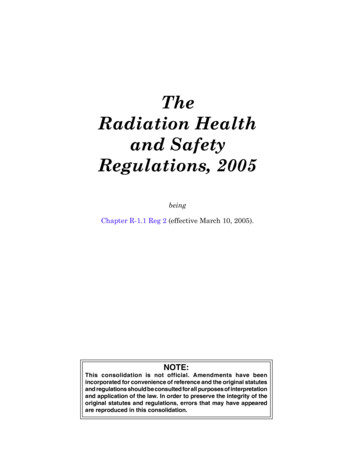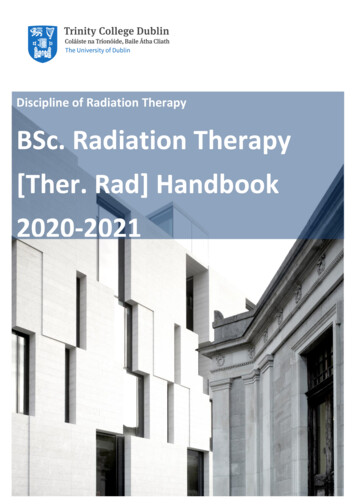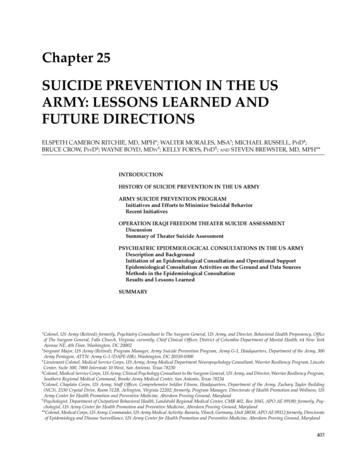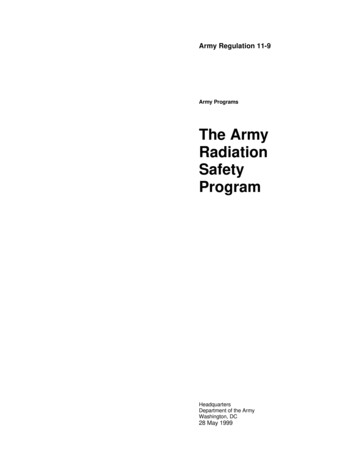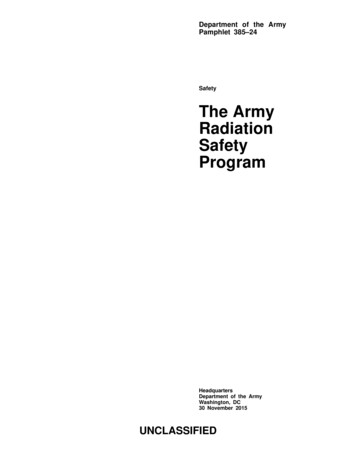
Transcription
Department of the ArmyPamphlet 385–24SafetyThe ArmyRadiationSafetyProgramHeadquartersDepartment of the ArmyWashington, DC30 November 2015UNCLASSIFIED
SUMMARY of CHANGEDA PAM 385–24The Army Radiation Safety ProgramThis major revision, dated 30 November 2015-oAdds a section for Inspector General inspections and audits (chap 1).oClarifies the Laser Safety Program (chap 3).oClarifies and expands guidance on the Electromagnetic Radiation SafetyProgram (chap 4).oClarifies and expands guidance for radiofrequency safety training (para 7-4).oClarifies enhanced security requirements for category 1 and 2 radioactivematerials and aligns it with Part 37, Title 10, Code of Federal Regulations(chap 8).oAdds Decommissioning Activities (chap 9).
*Department of the ArmyPamphlet 385–24HeadquartersDepartment of the ArmyWashington, DC30 November 2015SafetyThe Army Radiation Safety Programsafety activities. This pamphlet does notapply to nuclear weapons surety (AR50–5). Active Army, Army NationalGuard/Army National Guard of the UnitedStates, and U.S. Army Reserve personnelwho violate this pamphlet are subject topunishment under the Uniform Code ofMilitary Justice. Civilian and contractorsare subject to applicable civil or criminalstatutes.History. This publication is a majorrevision.Summary. This pamphlet establishesArmy radiation safety procedures. Itprovides guidance and direction to implement the safety requirements of AR385–10 and other Federal regulations andlaws. It provides guidance and direction toimplement DODI 6055.08, DODI 6055.11, DODI 6055.15, and DODI 5000.69. Itincludes Army guidance for the use, licensing, transportation, disposal,dosimetry, accident reporting, safety design, accountability of, and radiation exposure standards for ionizing and nonionizing radiation sources. This pamphletaddresses peacetime, deployment,redeployment, and wartime radiationContentsApplicability. This pamphlet applies tothe active Army, the Army NationalGuard/Army National Guard of the UnitedStates, and the U.S. Army Reserve, unlessotherwise stated. It also applies to all active duty Army military personnel at anytime, on or off a Department of Defenseinstallation; all Army civilian personnel ina duty status, on or off a Department ofDefense installation; all Army contractors;and all persons at any time on an Armyinstallation.Proponent and exception authority.The proponent of this pamphlet is the Director of the Army Staff. The proponenthas the authority to approve exceptions orwaivers to this pamphlet that are consistent with controlling law and regulations.The proponent may delegate this approvalauthority, in writing, to a division chiefwithin the proponent agency or its directreporting unit or field operating agency, inthe grade of colonel or the civilian equivalent. Activities may request a waiver tothis regulation by providing justificationthat includes a full analysis of the expected benefits and must include formalreview by the activity’s senior legal officer. All waiver requests will be endorsedby the commander or senior leader of therequesting activity and forwarded throughtheir higher headquarters to the policyproponent. Refer to AR 25–30 for specificguidance.Suggested improvements. Users areinvited to send comments and suggestedimprovements on DA Form 2028 (Recommended Changes to Publications andBlank Forms) directly to the Office of theDirector of Army Safety (DACS–SF),9351 Hall Road, Building 1456, Fort Belvoir, VA 22060–5860.Distribution. This publication is available in electronic media only and is intended for command levels A, B, C, D,and E for active Army, the Army NationalGuard/Army National Guard of the UnitedStates, and the U.S. Army Reserve.(Listed by paragraph and page number)Chapter 1Introduction, page 1Purpose 1–1, page 1References 1–2, page 1Explanation of abbreviations and terms 1–3, page 1Functions 1–4, page 1Deviations 1–5, page 8*This pamphlet supersedes DA Pam 385–24, dated 22 September 2011.DA PAM 385–24 30 November 2015UNCLASSIFIEDi
Contents—ContinuedChapter 2Ionizing Radiation Safety, page 8Army Radiation Safety Program 2–1, page 8Radiation safety key components 2–2, page 8General 2–3, page 9Control measures 2–4, page 9Nuclear Regulatory Commission licenses 2–5, page 10Army radiation authorizations 2–6, page 10Army radiation permits 2–7, page 11Army radiation safety record keeping 2–8, page 14Training 2–9, page 14Personnel monitoring 2–10, page 14Life cycle management for radioactive commodities and radiation generating devices 2–11, page 14Inventory and accountability 2–12, page 15Use and storage 2–13, page 15Internal and external program reviews 2–14, page 15Equipment calibration 2–15, page 15Survey instruments 2–16, page 15Radiation surveys 2–17, page 15Shipping, receiving, transferring, and transport 2–18, page 15Personnel Security Screening System 2–19, page 16Cargo and Vehicle Security Screening System 2–20, page 16Emergency response 2–21, page 16Foreign and captured material 2–22, page 16Range maintenance and disposal 2–23, page 16Handling and disposal of unwanted radioactive material 2–24, page 17Chapter 3Laser Safety, page 17General 3–1, page 17Military-exempt lasers 3–2, page 18Laser Safety Program 3–3, page 18Chapter 4Electromagnetic Radiation Safety, page 19General 4–1, page 19Measurement and evaluation of electromagnetic field from 0 Hz to 300 GHz 4–2, page 20Electromagnetic field controls 4–3, page 20Duties of the Radio Frequency Safety Officer 4–4, page 21Siting of commercial telecommunications equipment on Army installations 4–5, page 21Chapter 5Radiation Safety Standards, Area Designations, and Contamination Limits, page 22General 5–1, page 22Area designations 5–2, page 22Radioactive contamination 5–3, page 22Chapter 6Special Reporting Requirements, page 24General 6–1, page 24Other required reporting agencies and time requirements 6–2, page 25Radiological Accident/incident Report 6–3, page 26iiDA PAM 385–24 30 November 2015
Contents—ContinuedChapter 7Training Requirements for Radiation Safety Officers, Laser Safety Officers, and Radiofrequency SafetyOfficers, page 26General 7–1, page 26Radiation safety officer training requirements 7–2, page 26Laser safety training requirements 7–3, page 27Radiofrequency safety training requirements 7–4, page 28Chapter 8Enhanced Security Requirements for Radionuclides of Concern, page 29General 8–1, page 29Radioactive Source Categories 8–2, page 29Unescorted access authorization 8–3, page 31Security of radionuclides of concerns 8–4, page 32Chapter 9Decommissioning of Facilities, page 33General 9–1, page 33Classification for decommissioning purposes 9–2, page 33Procedure 9–3, page 33Typical process for areas that leave Army control 9–4, page 33Typical process for areas that will not leave Army control 9–5, page 35AppendixesA.References, page 37B.Annual Radiation Safety Audit Checklist, page 46Table ListTable 5–1:Table 5–2:Table 5–3:Table 6–1:page 25Table 8–1:Army personnel ionizing radiation exposure standards, page 23Electromagnetic radiation, page 23Screening levels for clearance, page 24Army Materiel Command Nuclear Regulatory Commission commodity license radiation safety officers,Radionuclides of concern, page 30Figure ListFigure 2–1: Sample Army Radiation Permit, page 13Figure 8–1: Unity rule for Category 2 sources, page 31GlossaryDA PAM 385–24 30 November 2015iii
Chapter 1Introduction1–1. PurposeThis pamphlet contains technical requirements for developing management and control processes for operationsinvolving sources of radiation, and its implementation is necessary to meet the requirements of AR 385–10. Itsobjective is to ensure the safe use of radiation sources and compliance with all applicable Federal and Department ofDefense (DOD) rules and regulations.1–2. ReferencesSee appendix A.1–3. Explanation of abbreviations and termsSee the glossary.1–4. FunctionsBased upon the responsibilities as defined in AR 385–10, the following organizations support radiation safety byproviding the following functions:a. Assistant Secretary of the Army (Installations Energy, and Environment). The ASA (IE&E)—(1) Establishes overall Army environmental, safety, and occupational health policy that includes radiation safety.(2) Maintains general oversight of, and serves as the advocate for, the ARSP and the Career Program 12 Safety andOccupational Health Program, which covers job series 1306 Health Physicists.b. Assistant Secretary of the Army (Manpower and Reserve Affairs). The ASA (M&RA)—(1) Establishes overall Army health and preventive medicine policy.(2) Maintains oversight of medical and health aspects of the ARSP.c. The Inspector General. The IG—(1) Conducts radiation safety inspections and license compliance audits of the ARSP.(2) Establishes standard inspection policies, procedures, and techniques for the conduct of these inspections andaudits to include periodic coordination and consultation with Headquarters, Department of the Army (HQDA) officesand Army organizations to help ensure a common understanding of regulations and guidance.(3) Requests support from the Army staff and subordinate headquarters for the resources and expertise necessary toensure accomplishment of the technical inspection mission.d. Director of Army Safety, Office of the Chief of Staff, Army. The DASAF—(1) Chairs the Army Radiation Safety Council (ARSC) as the Army staff component providing oversight of theARSP.(2) Provides Army guidance and procedures to implement requirements of—(a) Title 10, Code of Federal Regulations (10 CFR).(b) 21 CFR Food and Drug Administration (FDA), that covers electronic products, to include x-ray systems, lasers,and electromagnetic radiation producing devices from 0 Hz to 300 GHz to include radio frequency (RF) systems:(c) 29 CFR.(d) 32 CFR 655.10.(e) 40 CFR.(f) 49 CFR.(g) Department of Defense Instruction (DODI) 6055.08.(h) DODI 6055.11.(i) DODI 6055.15.(j) DODI 5000.69.(3) Administers, directs, and integrates risk management (RM) in accordance with AR 385–10, DA Pam 385–30,and ATP 5–19.(4) Appoints in writing the Army Radiation Safety Officer (ARSO), the Army Laser Safety Officer, and the ArmyRadiofrequency Radiation Safety Officer.e. Commanding General, U.S. Army Materiel Command. The CG, AMC—(1) Exercises administrative control over U.S. Nuclear Regulatory Commission (NRC) licenses and Army radiationauthorizations (ARAs) for Army radioactive commodities within AMC’s purview. This function is routinely managedby AMC major subordinate commands (MSCs). This includes, but is not limited to—(a) Acquires, amends, and maintains NRC licensees for radioactive commodities.(b) Exercises administrative control over licenses.(c) Coordinates NRC license correspondence with applicable commands and the ARSO.DA PAM 385–24 30 November 20151
(d) Ensures reporting license violations to the NRC by the appropriate subordinate command that is the NRC licenseholder in accordance with 10 CFR and notifying the ARSO.(e) Performs or coordinates license compliance audits for activities that use AMC-licensed radioactive commodities.(f) Coordinates with U.S. Army Training and Doctrine Command (TRADOC), U.S. Army Medical Command(MEDCOM), and applicable licensees to ensure training materials meet NRC license conditions.(2) Provides personnel dosimetry services through the Army Dosimetry Center (ADC). The Chief, ADC (inaccordance with 10 CFR 20.1501(d), AR 385–10, DA Pam 385–25, and this pamphlet)—(a) Publishes instructions for starting, maintaining, and ending personnel dosimetry services.(b) Maintains the Army’s Central Dosimetry Records Repository (CDRR). The CDRR archives comprehensivedosimetry records for all Army personnel and for other personnel who use Army dosimetry services. Records mustmeet the requirements of 10 CFR 20.2106, 10 CFR 20.2110, and OSHA 1910.1096(b)(2)(iii). Records include resultsof bioassays, administrative dose assignments (including copies of documents that make the assignments), and supplementary occupational dose equivalent information (for example, dosimetry information resulting from off-duty employment) that radiation safety officers (RSOs) reports. In particular, the ADC must meet the requirements of 10 CFR 20.2106(f) for long-term retention of these records.(c) Provides personnel dosimetry records (automated dosimetry report) to RSOs for all personnel who receiveddosimetry services during the previous calendar quarter. These reports enable supported RSOs to meet all recordkeeping requirements in 10 CFR 20.2106.(d) Provides reporting services that enable RSOs to meet all requirements of 10 CFR 19.13, 29 CFR 1910.1096(n)and (o), and 29 CFR 1926.53.(e) Provides reporting services that meet the requirements of 10 CFR 20.2206.(f) Immediately notifies (by telephone or message) the RSO, the radiological hygiene consultant to The SurgeonGeneral (TSG), the command Radiation Safety Staff Officer (RSSO), and the ARSO when dosimetry results indicatethat any Army personnel ionizing radiation exposure standard (see table 5–1) may have been exceeded.(3) Provides Army low-level radioactive waste disposal services (by the Army Low-Level Radioactive WasteDisposal Division, U.S. Army Joint Munitions Command, Safety/Rad Waste Directorate, AMSJM–SF, Rock Island, IL61299–6000). In addition—(a) Establishes procedures for implementing the Army’s responsibility as DOD lead agency for unwanted radioactive material disposal.(b) Maintains records of all Army radioactive waste disposal by burial or recycling.(4) Provides the Army radiation test, measurement, and diagnostic equipment program and accredited radiationinstrument calibration services (see AR 750–43 and Technical Bulletin (TB) 750–25).(5) Assumes responsibility in the event of an NRC violation or radiation accident at a facility involving AMClicensed radioactive materials (RAMs) that result in NRC Escalated Enforcement Action against an AMC commoditylicensee, any resulting administrative civil penalty is shared between AMC and the responsible command as mutuallyagreed between their respective radiation safety offices, based on an evaluation of the nature of the alleged violationsand penalty assessment.(6) Ensures that foreign military sales of RAM, items that contain RAM, radiation generating devices, and militaryexempt lasers comply with applicable U.S. regulations and DOD directives.(7) Appoints, in writing, an AMC RSSO to help oversee the AMC Radiation Safety Program (RSP).(8) Resolves radiation issues among AMC commands as necessary.f. The Surgeon General. TSG—(1) Approves and provides radiation dose limits and deviations to previously published dose (DA Pam 385–25 andAR 385–10) to the ARSO for promulgation as necessary (see para 1–4m(3)).(2) Provides Army staff supervision on the medical aspects of ionizing and non-ionizing radiation injury.g. Commanding General, U.S. Forces Command. The CG, FORSCOM—(1) Ensures command compliance with conditions of NRC licenses and ARAs, including AMC-held radioactivecommodity licenses (see para 2–1b). The CG should use a memorandum of agreement or similar mechanisms to clarifythe relationship between the U.S. Army Headquarters (Army commands (ACOMs), Army service component commands (ASCCs), direct reporting units (DRUs), and the NRC license holder.(2) Designates, in writing, a trained RSSO.(3) Issues ARAs (see para 2–3).(4) Establishes and employs, as applicable, procedures to ensure that captured, purchased, borrowed, or otherwiseobtained foreign equipment and materiel is surveyed for RAM and that appropriate actions are taken followingdiscovery of any RAM in those items.(5) Maintains the RSP by:(a) Establishing review and approval procedures for integrating RM in accordance with AR 385–10, DA Pam385–30 and ATP 5–19.(b) Ensuring, for programs under their purview, that each NRC license, Army reactor permit, ARA, and RSP is2DA PAM 385–24 30 November 2015
reviewed annually and inspected periodically for compliance with applicable radiation safety and health regulations andguidance. These inspections should be performed at a frequency commensurate with the associated hazard, but not toexceed 3 years. These services may be provided by U.S. Army Public Health Command (USAPHC).(6) Ensures a laser safety program is in place for the command and appoints a properly trained laser safety officer(LSO) in writing to manage the program. Maintain the Laser Safety Program by:(a) Tracking DOD military-exempt lasers to ensure compliance with the FDA military exemption (FDA exemptionno. 76EL–01DOD), proper disposal of DOD military exempt lasers that are not classified in the interest of nationaldefense, and ensuring lasers are brought into compliance with the FDA regulations.(b) Disposing unusable lasers or laser parts to the Defense Reutilization and Marketing Service for utilizationscreening within DOD (see DOD 4160.21–M–1).(7) Ensures an electromagnetic radiation safety program is in place and appoints a properly trained radiofrequencysafety officer (RFSO) in writing to manage the program (see AR 385–10).h. Commanding General, U.S. Army Training and Doctrine Command. The CG, TRADOC—(1) Integrates appropriate radiation safety training in military occupational specialty and specialty skill identifierproducing courses.(2) Makes available radiation safety training modules for deploying and deployed personnel about protection fromU.S. and foreign ionizing and non-ionizing radiation sources (including depleted uranium (DU) munitions) that mayexpose Army personnel to radiation during deployment (see AR 385–10).(3) Provides short courses to qualify unit, garrison, installation, Army National Guard (ARNG), and U.S. ArmyReserve (USAR) RSOs. (For the purposes of this pamphlet, short courses are 3 weeks or less in duration) (see AR385–10).(4) Coordinates training material with the appropriate Army commodity licensees and MEDCOM to ensure NRCand ARA compliance with training materials.i. Commanding General, U.S. Medical Command. The CG, MEDCOM—(1) Makes available radiation safety training modules for deploying and deployed personnel about health hazards of,protection from, and medical treatment of injuries caused by U.S. and foreign ionizing and non-ionizing radiationsources (including DU munitions) that may expose Army personnel during deployment.(2) Provides, with services available from the USAPHC on a reimbursable basis, RSP assessment services forgarrison surveys to assist and ensure NRC license, Army reactor permit, ARA holder regulatory compliance or Federal/Army regulatory compliance. Establishes, when required, appropriate occupational health surveillance programs forpersonnel occupationally exposed to radiation.(3) Performs health hazards assessments of commodities and systems that emit radiation or contain RAM as early aspractical in development and before fielding (see AR 40–10).(4) Provides, with services available from USAPHC, radiation bioassay services (see AR 40–5 and DA Pam385–25) that comply with criteria of the American National Standards Institute (ANSI) N13.30).(5) Provides medical support for investigations of alleged radiation exposures in excess of established limits (seeDODI 6055.05, DODI 6055.08, DODI 6055.11, DODI 6055.15, and DA Pam 385–25).(6) Coordinates training material with AMC commodity licensees, ARA holders, and TRADOC to ensure fieldcompliance with AMC NRC licenses and ARAs.j. Assistant Chief of Staff for Installation Management. ACSIM—(1) Provides oversight for all radioactive contamination surveys conducted in support of base closure or installationrestoration activities as per AR 385–10.(2) Ensures closure surveys are conducted in accordance with applicable state, local, and NRC requirements.Implementation guidance is found in the Multi-Agency Radiation Survey and Site Investigation Manual (MARSSIM)and agreements with regulatory agencies.(3) Coordinates surveys with the responsible NRC license holder and ARA holder.(4) Ensures contamination surveys solely releasing areas where AMC NRC license radioactive commodities wereused follow chapter 9 guidance for surveying radioactive commodity sites.k. Commanding General, U.S. Army Intelligence and Security Command. Ensures that the National Ground Intelligence Center provides expertise as required to properly identify foreign radiological sources and equipment known tocontain radioactive sources.l. Commander or Director Army command, Army service component command, direct reporting unit. Each ACOM,ASCC, DRU commander and director—(1) Ensures command compliance with conditions of NRC licenses and ARAs, including AMC-held radioactivecommodity licenses (see para 2–1b). Considers using memorandum of agreement or similar mechanisms to clarify therelationship between the Army Headquarters ACOMs, ASCCs, DRUs, and the NRC license holder.(2) Designates, in writing, an RSSO who is properly trained and qualified (see chap 7).(3) Issues ARAs (see para 2–3).(4) Establishes and employs, as applicable, procedures to ensure that captured, purchased, borrowed, or otherwiseDA PAM 385–24 30 November 20153
obtained foreign equipment and materiel are surveyed for RAM and that appropriate actions are taken followingdiscovery of any RAM in those items.(5) Maintains the RSP by—(a) Establishing review and approval procedures for integrating RM into all operations involving radioactivematerials in accordance with AR 385–10, DA Pam 385–30 and ATP 5–19.(b) Ensuring the RM process is executed before conducting radioactive materials operations.(c) Ensuring, for programs under their purview, that each NRC license, Army reactor permit, ARA, and RSP isreviewed annually and inspected periodically for compliance with applicable radiation safety and health regulations andguidance. These inspections should be performed at a frequency commensurate with the associated hazard, but shouldnot to exceed 5 years.Note. Applicable radioactive commodity licensees may require more frequent inspections. These services may be provided by the IGor USAPHC.(d) Ensuring, that in the event of an NRC violation or radiation accident at a facility involving AMC-licensed RAMsthat result in NRC escalated enforcement actions against an AMC commodity licensee, any resulting administrativecivil penalty is shared between AMC and the responsible command as mutually agreed between their respectiveradiation safety offices, based on an evaluation of the nature of the alleged violations and penalty assessment.(6) Ensures a laser safety program is in place for the command if Class 3B and Class 4 lasers are in use, and appointa properly trained LSO, in writing, to manage the program.(a) Tracks DOD military-exempt lasers to ensure compliance with the FDA military exemption (FDA exemption no.76EL–01DOD). Dispose of DOD military exempt lasers that are not classified in the interest of national defense andhave usable lasers or laser parts through utilization outside of the DOD, through donation or sale only after ensuringthat the laser is brought into compliance with the FDA regulations or the purchaser requests a variance from the FDA,or in the case of foreign military sales, the latest guidance from the FDA is followed.(b) Disposes of unusable, classified lasers or laser parts to the Defense Logistics Agency Disposition Services forutilization screening within DOD (see DOD 4160.21–M–1).1. Maintains accountability during the screening period. (Losing and gaining organizations transfer excess directlybetween themselves.)2. Identifies requirements for usable parts and returning them to the supply system after utilization screening hasbeen completed.(7) Ensures an electromagnetic RSP is in place, if necessary, and appoint a properly trained RFSO in writing tomanage the program (see AR 385–10).m. Commander or director. Each commander or director—(1) Designates, in writing, a RSO when any of the following is true:(a) An NRC license, Army reactor permit, ARA, or applicable technical publication requires an RSO to beappointed.(b) Requires personnel in the command to wear ADC-issued dosimetry (see para 5–1d).(c) Requires personnel in the command to participate in a bioassay program (see para 5–1e).(d) A deployable unit possesses radioactive commodities or radiation emitting equipment that requires the implementation of an RSP (for example, leak testing, radiation postings, and shipping requirements).(2) Designates, in writing, an LSO when any of the following is true:(a) The activity operates, maintains, or services a Class 3B or Class 4 Laser System (see ANSI Z136.1).(b) The activity operates, maintains, or services military-exempt laser systems.(3) Designates, in writing, an RFSO whenever there are RF or electromagnetic radiation (EMR) sources from thatexceed the exposure reference levels (ERLs) limits of IEEE C95.1–2345.(4) Ensures that when paragraphs 1–4l(1), 1–4l(2), and 1–4l(3) of this pamphlet requires the designation of an RSO,LSO, or RFSO—(a) The RSO, LSO, or RFSO designee is trained (and periodically retrained, as necessary) to a level commensuratewith the RSP scope and responsibilities (see chap 7).(b) The RSO, LSO, and RFSO ensures that the command’s written radiation safety policies and procedures are incompliance with applicable Federal, DOD, and Army radiation safety regulations and directives. These documentsinclude emergency reaction plans, as necessary, and procedures for investigating and reporting radiation accidents,incidents, and over exposures (see chap 6).(c) The RSO, LSO, and RFSO ensures that they or an internal or external agent or agency audits the RSP annuallyand copy furnishes the garrison RSO and the command RSSO.(5) Ensures all personnel occupationally exposed to radiation receive appropriate radiation safety training commensurate with potential workplace hazards.(6) Maintains an inventory of licensed or authorized ionizing radiation sources, Class 3B, Class 4, and militaryexempt lasers, and EMR sources from 0 Hz to 300 GHz that can exceed the ERL of IEEE C95.1–2345, Army reactor4DA PAM 385–24 30 November 2015
permits, ARAs, and technical publications. Inventories must be updated annually or more often if required by NRClicense conditions or local procedure. A copy of the inventory will be furnished to the garrison RSO annually (or morefrequently if necessitated by inventory changes) and to the command RSSO.(7) Establishes written policies and procedures to ensure compliance with radiation safety requirements in applicabletechnical publications governing the use of radioactive commodities, lasers, and EMR sources from 0 Hz to 300 GHz(see para 2–3b(1)).(8) Establishes radiation safety committees (RSCs) required by technical publications or conditions of an NRClicense, Army reactor permit, or ARA, in accordance with AR 385–10.(9) Oversees the integration of RM into the ARSP.(10) Reports radiation accidents and incidents when required by AR 385–10, DA Pam 385–40, 10 CFR, or 49 CFRto the chain of command, the command RSSO, the appropriate NRC license holder, and the garrison RSO.n. Commander, garrison. Each garrison commander—(1) Designates as necessary, in writing, a garrison RSO who is properly trained and qualified (see chap 7).(2) Establishes an RSC for the senior commander as proscribed in AR 385–10.(3) Prepares and maintains historical records of locations of use or storage of RAM on the installation and theresponsible activity for that use or storage (see para 2–8c).(4) Maintains documentation listing locations categorized as “RF controlled environments” where potentialelectromagnetic field (EMF) exposures to personnel above the action level could occur, as per DODI 6055.11 andchapter 4, below.(5) Issues Army radiation permits (ARPs) (see para 2–7 and AR 385–10).(6) Obtains radiation safety resources from outside the command by contracting, memorandum of agreement, ormemorandum of understanding, as necessary, to meet the garrison RSP requirements, if the organization lacks organiccapability.(7) Maintains an inventory of radiation sources as higher headquarters directs and in accordance with requirementsof NRC licenses, Army reactor permits, ARAs, and technical publications. Inventories are updated annually or moreoften if required by NRC license conditions or local procedure.(8) Establishes written policies and procedures to ensure compliance with radiation safety requirements in applicableregulations and technical publications governing the use of radioactive commodities (see para 2–3b(1)).o. Army radiation safety officer. The ARSO—(1) Oversees the ARSP on behalf of the DASAF.(2) Develops, manages, and promulgates Army radiation safety policy and guidance on behalf of the DASAF.(3) Promulgates Federal and Army radiation safety personnel exposure standards within the Army in coordinationwith the radiological hygiene consultant to TSG.(4) Provides HQDA oversight of the DOD executive agency for low-level radioactive waste, to include mattersconcerning DU on behalf of the ASA (IE&E).(5) Resolves radiation safety issues among U.S. Army Headquarters as necessary.(6) Promotes good radiation safety practices throughout the Army.(7) Provides radiation safety consultation to the DA staff, U.S. Army Headquarters commanders and staffs.(8) Serves as HQDA radiation safety point of contact with other DOD and Federal agencies.(9) Represents HQDA on DOD RSCs, working groups, and panels.(10) Provides technical input to HQDA-level radiation safety plans and responses to radiation emergencies, accidents, and incidents.p. Radiation safety staff officers. The ACOMs, DRUs RSSOs—(1) Ensures implementation of Army radiation safety policy within their respective areas of responsibility.(2) Oversees their command’s RSP.(3) Establishes radiation safety policy for their respective areas of responsibility.(4) Provides radiation safety co
Contents—Continued Chapter 2 Ionizing Radiation Safety, page 8 Army Radiation Safety Program † 2-1, page 8 Radiation safety key components † 2-2, page 8 General † 2-3, page 9 Control measures † 2-4, page 9 Nuclear Regulatory Commission licenses † 2-5, page 10 Army radiation authorizations † 2-6, page 10 Army radiation permits † 2-7, page 11


